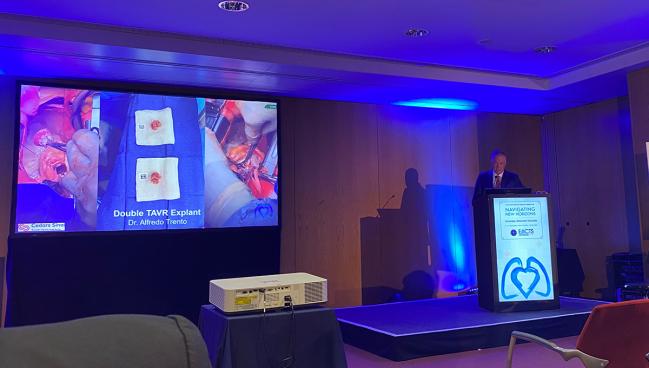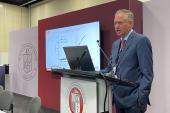TAVI Explant Complications a ‘Big Issue’ as Procedure Numbers Climb
New single-center data should spur surgeons to be active in lifetime management conversations at the outset.

CORRECTION: An earlier version of this article mistakenly indicated that Cedars-Sinai Smidt Heart Institute performed almost as many TAVI explantations as implants in 2023. In fact, the institution performed more than 600 TAVIs that year and about 10 explant surgeries.
LISBON, Portugal—Highlighting the growing concerns surrounding the risks of TAVI explantation, data from a single, high-volume US center show that explant procedures for failed TAVI devices—which have been steadily rising in frequency—were associated with a high rate of morbidity or mortality within 30 days.
“As we see more and more TAVRs put in younger patients, there will probably still be a need for this operation that we need to learn how to do,” said Michael Bowdish, MD (Cedars-Sinai Smidt Heart Institute, Los Angeles, CA), who presented the findings during the European Association for Cardio-Thoracic Surgery (EACTS) 2024 meeting earlier this month. Previous data suggest that higher-volume centers may have better outcomes with this surgery and “you may see some of these risks start to come down,” he said, “but [it’s] something to think about as we look forward.”
The findings are in line with previous data Bowdish presented from the Society of Thoracic Surgeons (STS) Adult Cardiac Surgery Database, which showed a 14.1% operative mortality rate for SAVR with or without other cardiac surgery following TAVI. Other studies have highlighted the overall riskiness of TAVI explant, with surgeons warning about the increased need for lifetime management of aortic stenosis when considering TAVI in patients with longer life expectancies.
“This is a big issue,” Patrick Myers, MD (Lausanne University Hospitals, Switzerland), who serves as the secretary general of EACTS, told TCTMD. “TAVI in young patients is the fastest-growing operation in the STS database, [and] this is a tsunami of patients that we're looking at that, for the moment, we will have poor results. So as surgeons, we're trying to organize how to manage that.”
TAVI Explant Findings
For the analysis, Bowdish and colleagues looked at 46 adult patients with a history of TAVI (mean age 70.4 years; 50% male) who underwent SAVR with (n = 33) or without (n = 13) concomitant procedures at their institution between 2011 and 2023. Just over half (52%) had NYHA class III/IV symptoms at baseline and the median STS predicted mortality was 5%.
Balloon expandable TAVI devices had been used for the initial procedure in the vast majority (89%) of patients. Additionally, 70% had a native TAVI valve explanted with the remaining 30% having a TAVI-in-SAVR valve removed. Stenosis was most often caused the need for explant (39%), followed by endocarditis (22%), insufficiency/paravalvular leak (22%), and mixed stenosis/insufficiency (15%).
Among those undergoing additional surgeries, 42% had a mitral/tricuspid valve intervention, 39% received an aortic valve intervention, 9% had CABG, and 9% had a combination. The median time from TAVI to explant was 379 days.
The presumption that a person who gets a TAVR won't ever have heart surgery is clearly not true. Michael Bowdish
Bowdish showed that the rate of TAVI explants has steadily grown alongside the rate of first TAVI procedures at his institution.
At 30 days, the mortality rate for the overall TAVI explant cohort was 6.5%, and was noticeably higher at 9.1% for patients undergoing concomitant procedures. The 30-day rate of mortality, stroke, renal failure, new dialysis, permanent pacemaker implantation, prolonged ventilation, and return to OR was 28.3% overall—30.8% for those undergoing isolated SAVR and 27.3% for patients having concomitant procedures.
For those who fared well in that first month, however, survival at 5 years was “reasonable,” according to Bowdish, at 78.3% with no difference between those who did and did not undergo concomitant surgical procedures.
The study is limited by its single-center nature and by the fact that most of the explants were done by a single surgeon, he said. Additionally, the high percentage of balloon-expandable TAVI explants “potentially biases” the results, Bowdish suggested, because some surgeons consider these kinds of devices easier to remove.
The reason TAVI explant is “the largest growing operation” in the STS database is “because everything else is pretty static. I don't think we know what will happen 3, 4, 5 years down the road,” said Bowdish, who added, “I think we have a certain need to think about lifetime management and how we're going to deal with it. The presumption that a person who gets a TAVR won't ever have heart surgery is clearly not true.”
‘The First Cut Is the Deepest’
Session moderator Thomas Walther, MD, PhD (University Hospital Frankfurt, Germany), urged surgeons to participate more actively in heart team decisions early in the process. “We need to make sure that we see the patient at the initial time,” he said. “The first cut is the deepest.”
Myers agreed, likening the current operative mortality associated with TAVI explant to that of aortic dissection—"one of the surgical emergencies that we fear the most.”
If a patient who is eligible for either TAVI or surgery at the outset chooses the transcatheter route, then they tend to come back 10 years later with a greater comorbidity burden and more frailty, Myers said. If anatomy prevents them from having a TAVI-in-TAVI procedure, then SAVR with a TAVI explant—with its high operative and short-term mortality—is the only option left. Had they originally opted for SAVR, then redo SAVR—“a very low-risk operation”—would have been available, he pointed out.
TAVI in young patients is the fastest growing operation in the STS database, [and] this is a tsunami of patients that we're looking at that, for the moment, we will have poor results. Patrick Myers
The much higher risk with TAVI explant casts “into question the overall strategy” of choosing TAVI first under the assumption that complications can be managed over time with new devices and added experience, Myers said.
Yael L. Maxwell is Senior Medical Journalist for TCTMD and Section Editor of TCTMD's Fellows Forum. She served as the inaugural…
Read Full BioSources
Bowdish ME. Transcatheter aortic valve explant experience from a high-volume surgical structural heart center. Presented at: EACTS 2024. October 11, 2024. Lisbon, Portugal.
Disclosures
- Bowdish reports serving as the chair of the Society of Thoracic Surgeons Adult Cardiac Surgery Database task force as well as a senior editor of the Annals of Thoracic Surgery.





Comments